Herbs Comp - ID - no samples
1/14
There's no tags or description
Looks like no tags are added yet.
Name | Mastery | Learn | Test | Matching | Spaced |
|---|
No study sessions yet.
15 Terms

pinyin, latin category
Má Huáng / Ephedrae Herba 麻黃
A Herb - WARE
Properties: acrid, slightly bitter, warm Channel: LG, UB
SWEAR - Sweat. Wheezing. Edema. Absence (sweat), Release
-induces sweating,
- LU qi
-calms wheezing,
-promotes urination
- Warms
● Induces sweating and releases the exterior: for patterns of wind-cold exterior excess (taiyang cold damages) with chills, fever, HA, absence of sweating , and a tight, floating pulse. This herb is very effective in opening the pores and interstices to release the exterior.
● Disseminates and facilitates the Lung qi, calms wheezing, and stops coughing: for cough and wheezing due to wind-cold obstructing the Lungs. The herb both encourages the Lung qi to flow more easily, and directs it downward . Important for treating either externally contracted or internally-generated wheezing - use with xing ren: Xiao Qing Long Tang
● Promotes urination and reduces edema: especially for edema that accompanies an external condition.
● Warms and disperses cold pathogens: use for wind-dampness painful obstruction and deep-rooted toxic sores without a head, this is caused by localized accumulation of dampness.
use with fu zi for WC painful bi obstruction - warm and strongly dispersing, it drives out cold pathogens
- Mi zhi ma huang - removes the herb’s diaphoretic action but strengthens its effect in calming the lungs.
Cautions & Contraindications: because this has a rather strong effect of inducing sweating and
opening up the lungs, the dosage should not be too large. Nor should it be prescribed, without some
adjustment in the prescription, for those who are debilitated, those with spontaneous sweating with
exterior deficiency, those with night sweats from Yin deficiency, or those with wheezing associated with
the failure of the kidneys to accept qi.
Dosage: 2-9 grams
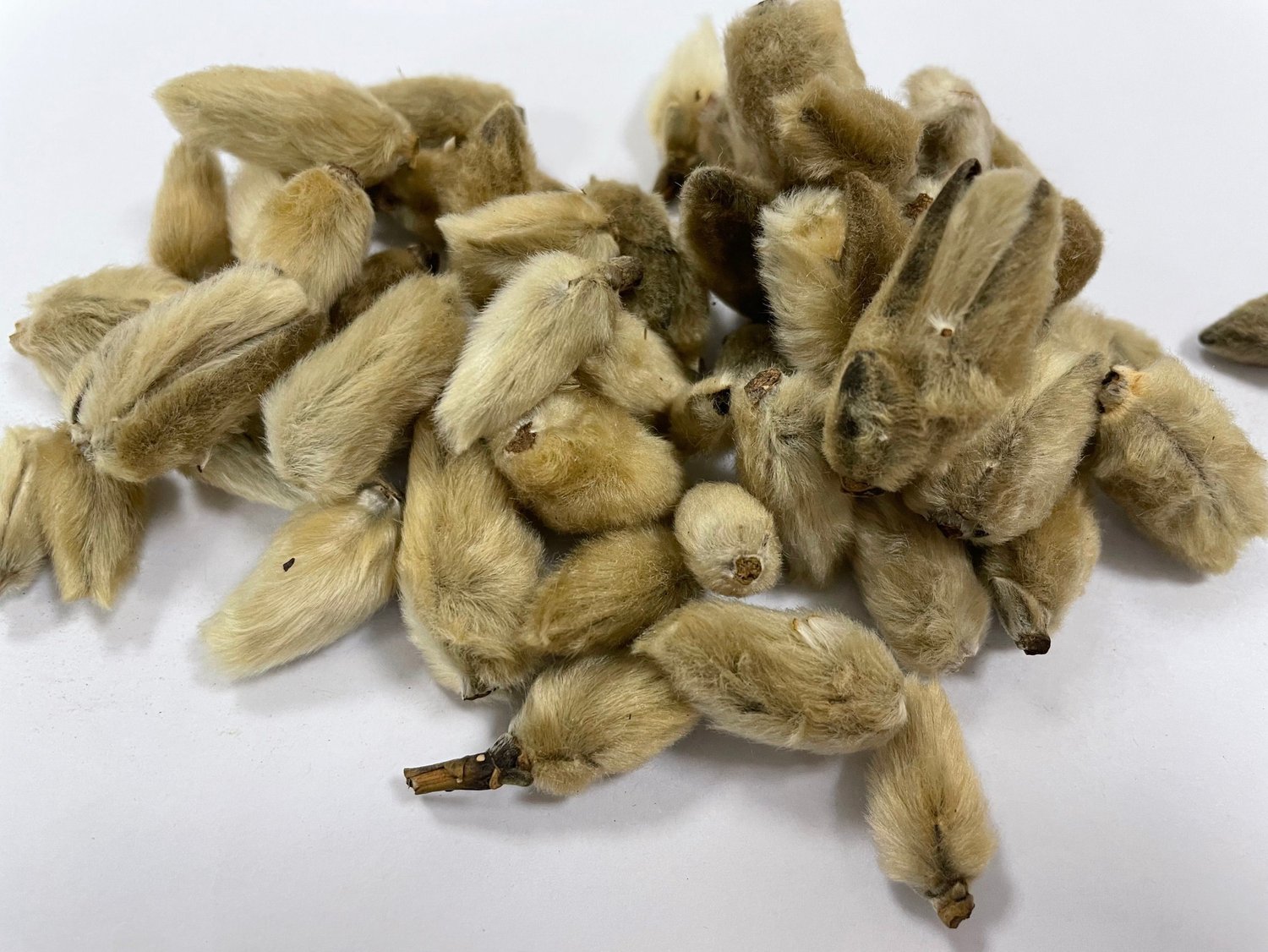
pinyin, latin category
Xin Yi (Hua) / Magnoliae Flos 辛夷
-study w/ Cang Er Zi
Properties: acrid, warm Channel: LU, ST
WARE - Warm Acrid Release the Exterior
XY - heat or cold. Hua → Nasal
-heat or cold
-clears the nasal passages,
relieves sinus headaches
Dosage : 3-9g. crush last 5-10 minutes
-not toxic.
-for open the nose
-frontal HA
Cautions & Contraindications: contraindicated in cases of fire from deficiency.
Actions & Indications:
1. Expels wind-cold and unblocks the nasal passages: for nasal congestion or obstruction, nasal discharge, lack of smell, sinus problems, or related HA. Primarily for W/C but can also be
used for any nasal or sinus condition with the right herbs.
- Light in nature but not very good at releasing the exterior
- Unblocks nasal passages
- Can be used with heat or cold.
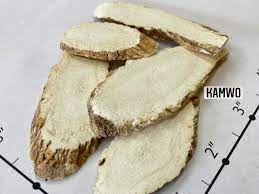
pinyin, latin category
Bai Zhi/ Angelica Dahuricae Radix 白芷
Properties: acrid, warming Channel: LG, ST, SP
ID - B Herb WARE
BZ - DNA P
Angela - Discharge, Nasal. Abscess - Pus/pain
-aromatic, warm, releases the exterior,
- opens the orifices (nose),
-dries dampness;
-discharge (vaginal)
pain
Once a sore has ulcerated, the use of this herb should be tapered off.
frequently used for frontal headaches
1. Expels wind, eliminates dampness, unblocks the nasal passages, and alleviates pain: for
patterns of externally-contracted wind-cold, esp those with HA. Also for supraorbital pain, nasal
congestion, and toothache. While primarily a warming herb, it can be used for any problem due to
wind invading the Yang Ming channels in the head.
2. Reduces swelling and expel pus: for early stages of superficial sores and carbuncles. If the sore, ulcer, or carbuncle has not yet suppurated, this herb will help reduce the swelling. If pus has already formed or the sore has ulcerated, the herb can be used to help discharge the pus.
used with Jing Jie if pus is not discharged; use with pu gong ying, gua lou, bei mu for breast
abscess.
**A boil (or furuncle) is an infection of a hair follicle that has a small collection of pus (called an abscess) under the skin
3. Expels dampness and alleviates discharge: usually for vagnial discharge due to cold-dampness in the lower burner, but with the appropriate herbs can also be used to treat vaginal discharge from damp-heat.
- fu ling, bai zhu, hai piao xiao - cold dp; huang bai, che qian
zi for damp-heat.
-acrid, dispersing, aromatic, unblocking, warm, and drying; all of these qualities makes it very effective in
eliminating dampness.
Dosage : 3-9g
Cautions & Contraindications: Contraindicated for problems due to yin deficiency or heat in the blood .

pinyin, latin category
Cang Er Zi / Xanthii Fructus 蒼耳子 “deep green ear seeds”
ID Herb - B Herb WARE Warm Acrid Release Exterior
Properties: sweet, bitter, warm, toxic Channel: LG
Cang rhymes with Pon
PON D SORE- pain obstruction, nasal. dampness. sores (skin)
-disperses wind,
-opens nasal passages
-removes painful obstruction,
-eliminates damp qi from the skin,
-toxic
-treats sores
Actions & Indications:
1. Disperses wind and dampness and opens the nasal passages: for any nasal or sinus problems with a thick, viscous discharge and related headaches. One of the main herbs for deep-source nasal congestion with HA, thick nasal discharge, and loss of smell. Use with Xi Yi, Bai Zhi as in Cang Er Zi San.
2. Disperses wind and dispels dampness: for wind-damp painful obstruction or skin disorders with itching - use with wei ling xian and chuan xiong for w/d painful obstruction
3. Dispels exterior wind: as an auxiliary herb for exterior disorders with a splitting HA that radiates to the back of the neck.
- Bitterness dries dampness, sweet flavor moderates this action so that it’s not extreme.
- Not too drying
Dosage : 3-9g
Cautions & Contraindications: overdosage can lead to vomiting, abdominal pain, and diarrhea. Some
text discourage eating pork while taking this herb
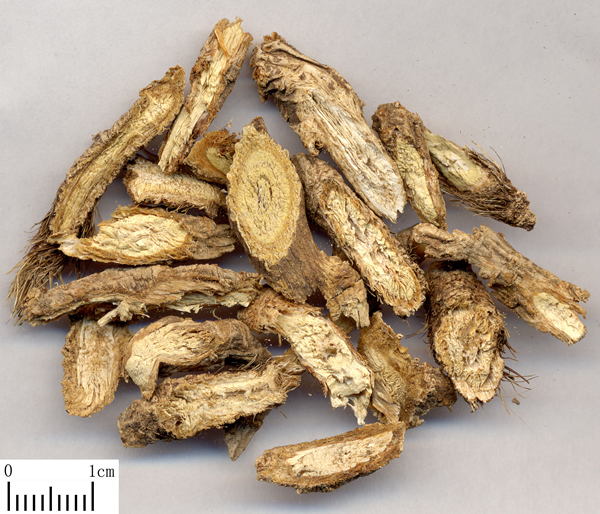
pinyin, latin category
*Fang Feng/Saposhnikoviae Radix 防風
-not as common on ID, but i’d still study
Standard Species: Saposhnikovia divaricata
Properties: acrid, sweet, slightly warm Channel: LG, LV
WARE - warm acrid release exterior
LAWD - less drying. all wind
-slightly warm. less drying. ALL wind.
-moderate, slightly warm, and less drying than most wind-expelling herbs;
-used for all wind disorders; treats dampness, and also diarrhea and pain in the bowels.
1)Release the exterior and expel wind:
2) Expels wind-dampness and alleviates pain:
wind cold painful obstruction. for bi syndrome, but mostly for external - like common cold whole body pain. heavy dampness
3) Expels wind and relieves spasms:
-not strong. auxiliary herb for trembling, spasm in feet, hands, etc. feet spasm recommends eating bananas function
Remarks:
Most moist of the expel wind herbs
Can treat intestinal wind - reducing tenesmus and reducing diarrhea (not in book I guess)
Dosage: 4.5-9g
Cautions & Contraindications: Contraindicated where there is repletion fire from yin deficiency, spasms from blood deficiency, or in the absence of pathogenic wind, dampness, or cold.
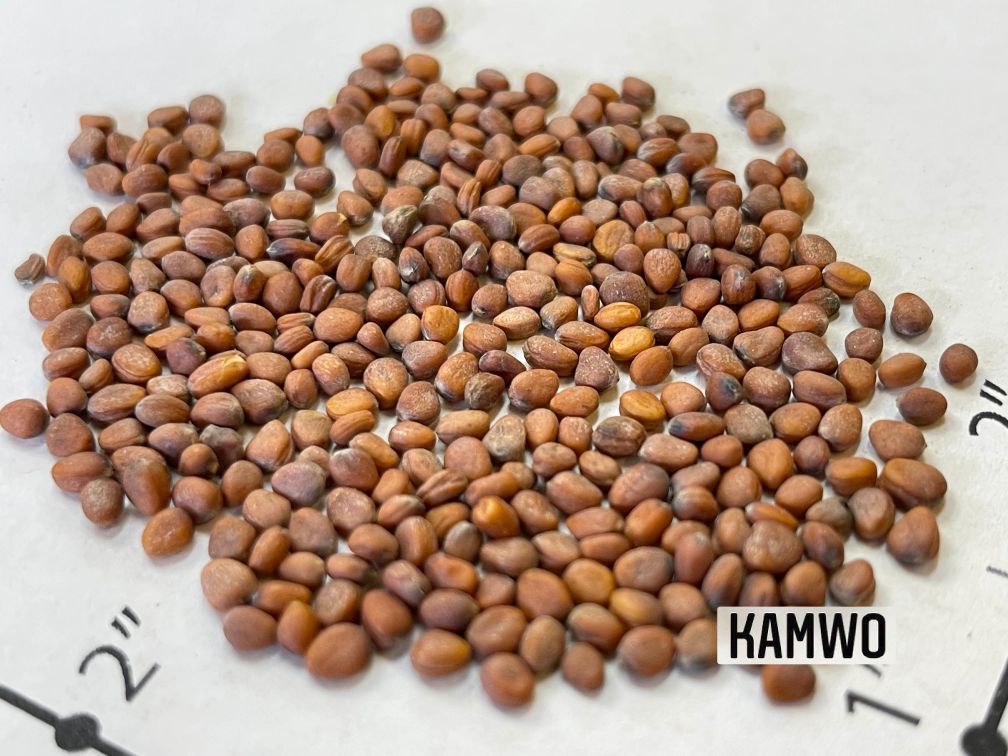
pinyin, latin category
Lái Fú Zǐ/Raphani Semen 萊菔子 pg.502
RELIEVE FOOD STAGNATION - B HERB
Standard species: Raphanus sativus English: radish seeds
Properties: acrid, sweet, neutral Channel: LG, LV, ST
Key characteristics: transform phlegm, reduces food stagnation, promotes the flow of qi in the Lungs, Spleen, and Large Intestines
Dosage: 4.5-9g.
Cautions & Contraindications: Inappropriate in the absence of food stagnation. Because it consumes the qi, it should not be taken long term. Unless it is used specifically to induce vomiting, it should be dried-fried.
Actions & Indications:
Reduces food stagnation and eliminates distention:
Causes qi to descend and reduces phlegm:
Recently used for Hypertension, as in Sān Zǐ Yǎng Qīn Tāng
Remarks:
Its raw form best for raising the qi - driving out wind-phlegm and relieving the upper jiao stifling sensation in the chest. Wind-stroke with phlegm welling upward, regurgitation of the obstructing pathogenic influence will provide great relief.
Dried fried, it directs the qi downward.
It extends through the lungs to direct the qi downward and transform phlegm
Mobilizes the Spleen channel to promote the flow of Spleen qi and reduced food stagnation
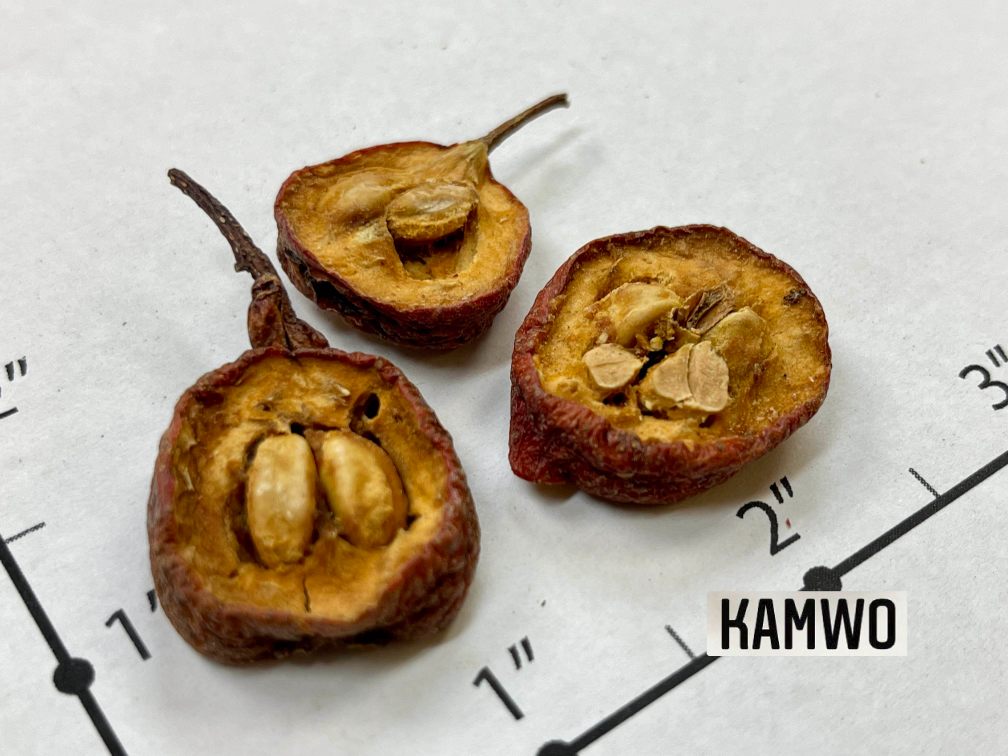
pinyin, latin category
Shān Zhā/Crataegus pinnatifida 山楂 pg.493
RELIEVE FOOD STAGNATION - A HERB
Standard species: Crataegus pinnatifida English: crataegus fruit
Properties: sour, sweet, slightly warm Channel: LV, SP, ST
Key characteristics: reduces food stagnation, especially from meat and greasy foods, invigorates the blood flow, alleviates diarrhea and dysentery
Dosage: 9-12g.
Cautions & Contraindications: Use with caution with weakness or deficiency of the Spleen and Stomach. Large doses are absolutely contraindicated during pregnancy, as this can lead to fetal death.
Actions & Indications:
Reduces food stagnation and transforms accumulation:
Transforms blood stasis and dissipates clumps:
Stops diarrhea:
Also recently used for hypertension, CAD, and elevated serum cholesterol
Remarks:
Sour, sweet, and slightly warm
Awakens the spleen, unbinds the stomach, promotes food intake, & assist digestion
Most useful in overindulgence of meat and greasy foods
Enters Liver channel blood level to disperse stasis, invigorate the blood, transform clumps and reduce distention.
Can also treat amenorrhea, abdominal masses, blood stasis following post-partum.
Chao shan zha enhances food stagnation
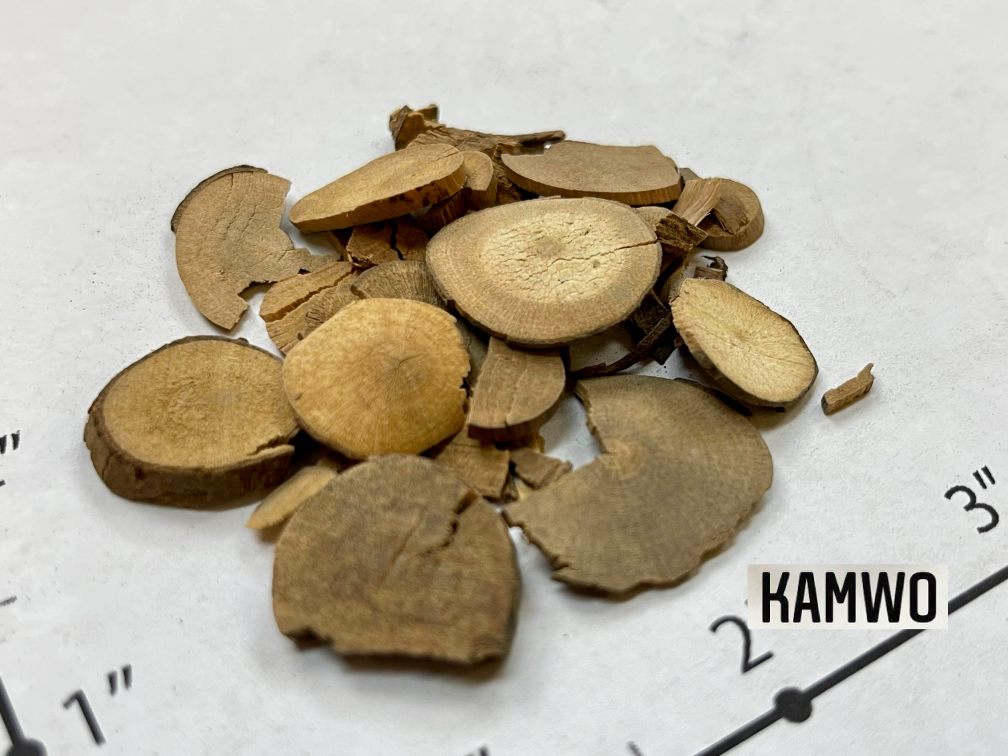
pinyin, latin category
Regulate Qi
*Wu Yao/ Linderae Radix 烏藥 “black medicine” A Herb - ID
Standard Species: Lindera aggregata
Properties: acrid, warm Channels: UB, KI, LU, SP
Dosage: 3-9g. Good quality is powdery, lacks black spots, and is light brown
Cautions & Contraindications: This herb is acrid, warm, and drying, it can disperse the qi and deplete the blood. It should not be used in those with significant qi and blood deficiency or internal heat.
Wu Black - Kidneys
-smooths flow of qi
-disperses cold
-alleviates pain
- Warms Kidneys
Actions & Indications:
Promotes the movement of qi and alleviates pain:
for cold stagnation. Disperses cold. Should be first to consider for cold stagnation. Can be menstrual cold, cold anywhere.
Warms the Kidneys:
frequent urination or urinary incontinence due insufficiency of KD yang. Its about descending of qi sending liquid down to kidneys. LU governs waterways. Here we’re losing due to lack of KD qi. Yang is manifestation of qi. Sufficient KD qi is required to hold urine, sperm, etc. Would have to recruit herbs that tonify KD qi. Also good for hernial pain.
often mistaken for Sang Zhi. Has a black tinge on it (like scuffed white sneakers). Herbs in this category are usually neutral. This one is functionally warming

pinyin, latin category
Regulate Qi
Xiang Fu Cyperi Rhizoma 香附 A Herb - ID
Standard Species: Cyperus rotundus
Properties: acrid, slightly bitter, slightly sweet, neutral Channels: LV, GB, TB
Dosage: 6-12g. Frying in vinegar increases the ability of this herb to enter the Liver channel and alleviate pain; frying in wine enables it to penetrate to all the channels. Good quality is large, solid, reddish brown, and aromatic.
Cautions & Contraindications: Contraindicated in those with qi deficiency and no stagnation, or in those with yin deficiency and heat, or heat in the blood. * sold as the zhi form
MP SpLr Q ;
-promotes the flow of qi in the LR and ST channels
-regulates menstruation
-alleviates pain
Actions & Indications:
Spreads and regulates Liver Qi:
constrained Liver qi patterns w/ hypochondriac pain as well as disharmony btwn LR and SP. ST/SP issues even in absence of LR, can be used an insurance in case
Regulates menstruation and alleviates pain:
painful menses or irregular menstruation. qi level. In real life, blocked menstruation will be both qi and blood stasis. Can use Dang Gui. Xiang Fu would be good for PMS (not Dang Gui)
tom: awesome herb. used in gyn all the time.
Chai Hu also spreads liver, but is more upper jiao diophoretic.
Xiang Fu spreads Lower Jiao.
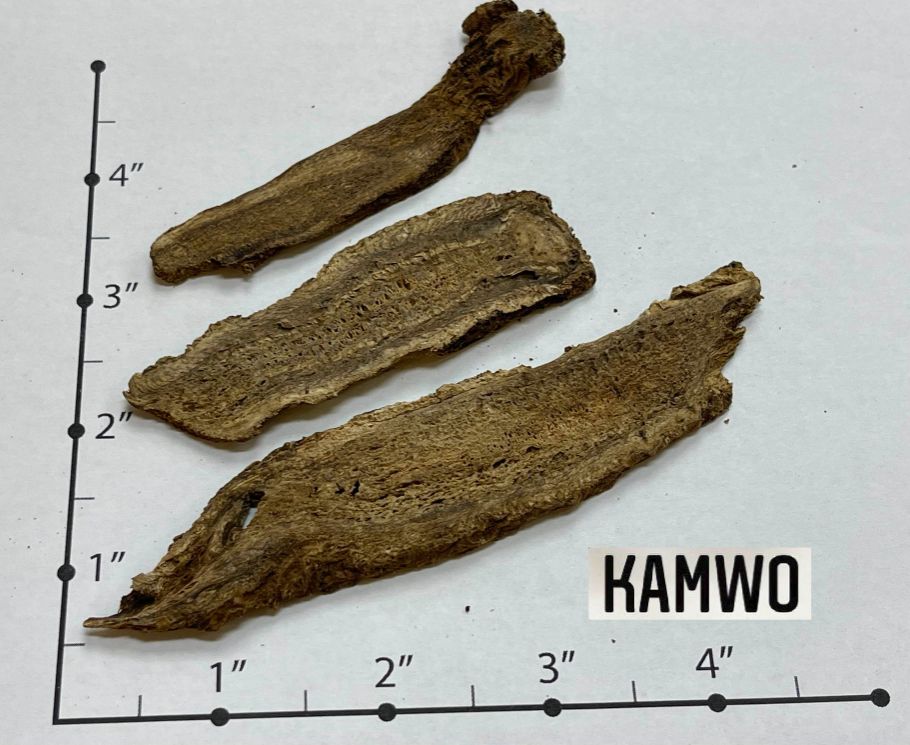
pinyin, latin category
Mu Xiang/ Aucklandiae Radix 木香 A Herb - ID
Standard Species: Aucklandia lappa
Properties: acrid, bitter, warm Channels: GB, LI, SP, ST, TB
SPIN - SP Intestines
-promotes the flow of qi
-stops pain
-strengthens the SP and eliminate food stagnation
Actions & Indications:
Promotes the movement of qi and stops pain:
pain from qi stagnation. St stagnant qi: lack of appetite, nauseausual MJ qi stagnation. Also used w/ stagnant GB. But more for SP and ST. GB pain can also be pain around ear, but also LJ damp heat.
Adjusts and Regulates Stagnant Qi in the Intestines:
special: restores normal qi dynamics of intestines. e.g. farting gurgling, constipation after eating spicy, raw garlic. also used for dysentery from damp heat. Can be used w/ Huang Lian which treats damp heat in LI. Mu Xiang will help regulate. Has a slightly astringing quality (good for dysentery. inflammation of LI - reuptakes water. inflammation prevents reuptake)
Strengthens the Spleen and prevents stagnation:
used w/ tonifying herbs to ameliorate their side effects. Mu Xiang is an insurance (like Chen Pi and Sha Ren) to prevent stagnation in formulas.
Dosage:3-9g. Add during the last five minutes of cooking. If used for chronic diarrhea, toast to increase its absorptive properties. Good quality is solid, aromatic, and slightly oily.
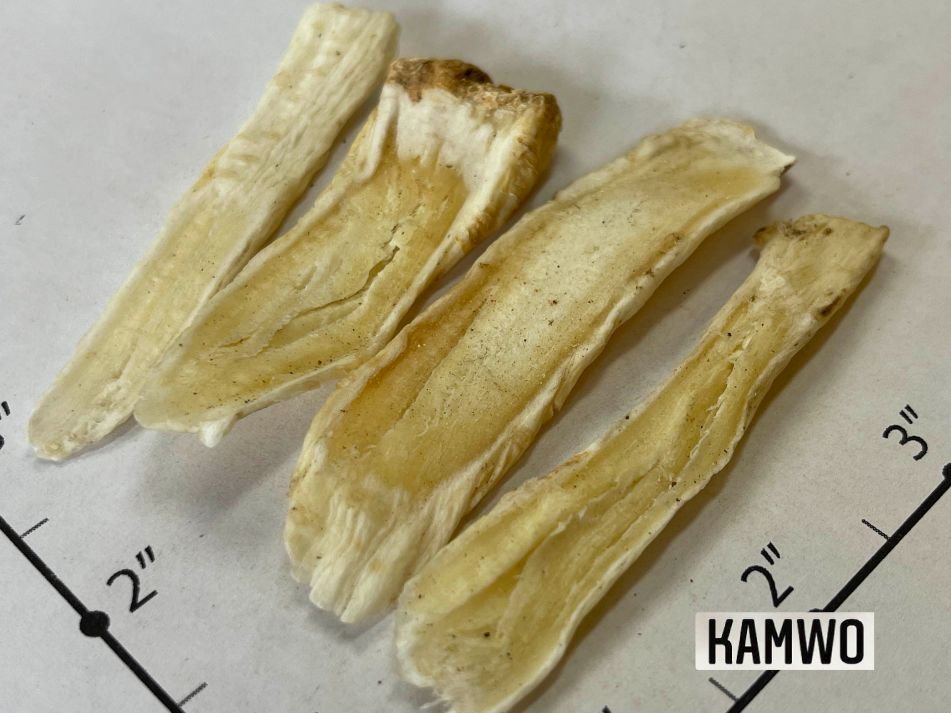
pinyin, latin category
Jié Gěng/Platycodi Radix 桔梗 pg.429
6.2 Warm Herbs that Transform Cold Phlegm
Standard species: Platycodon grandiflorus English: platycodon root
Properties: bitter, acrid, neutral Channel: LG
Key characteristics: causes the qi and the action of other herbs to rise, soothes the throat, releases the exterior, transform phlegm, expels pus
Dosage: 3-9g.
Cautions & Contraindications: because this herb’s acrid, dispersing, and draining qualities, it is contraindicated for chronic cough from yin deficiency or in patients with a tendency to cough up blood.
Actions & Indications:
Opens up and disseminates the Lung qi, dispels phlegm, and benefits the throat:
Pushes out pus:
Opens up and raises the Lung qi while also directing the actions of other herbs to the upper regions of the body:
Remarks:
Acrid that disperses, Bitterness drains
Light weight for ascending action
Has ascending and dispersing nature which raise and opens the Lung qi
Releases the exterior, benefits the throat, transforms phlegm, and expel pus.
Good combo with gan cao for sore throat
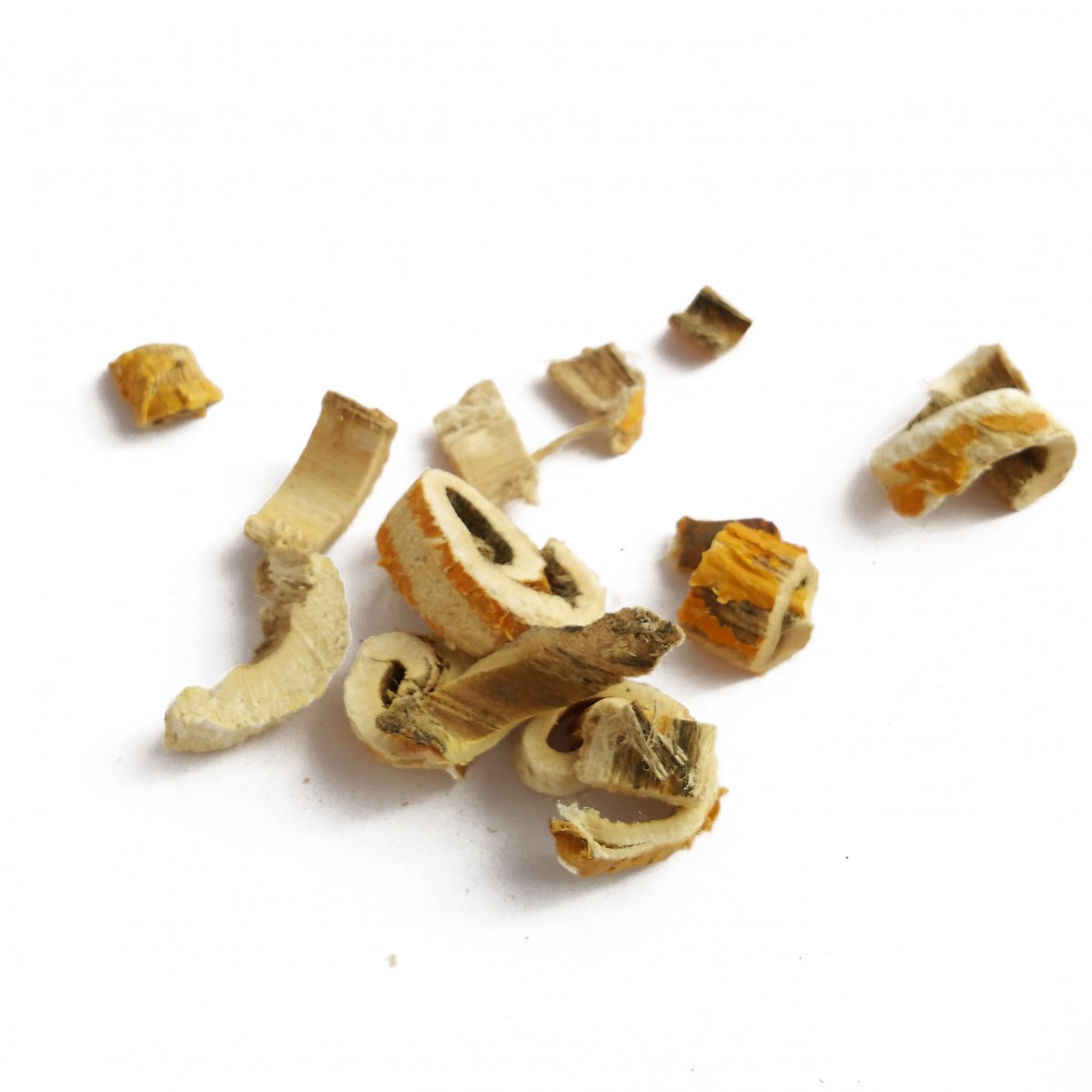
pinyin, latin category
Sāng Bái Pí 桑白皮 Mori Cortex Mulberry white bark
2. Promotes urination and reduces edema
LU heat obstructs the downward movement of LU qi, prevent water from moving and cutting off perspiration. This manifets as floating edema (promote urination), facial edema, swelling of the extremities, fever & thirst, urinary difficulty, & a floating pulse.
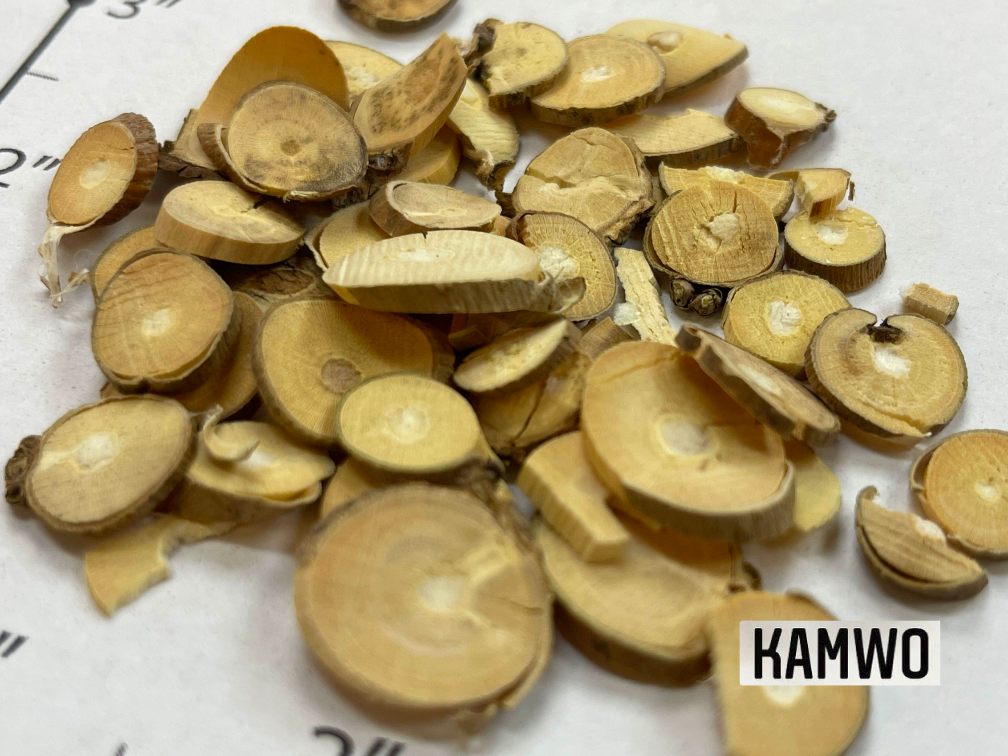
pinyin, latin category
Dispel Wind Dampness
Sang Zhi – unblk chan/collaterals
*Sāng Zhī/Mori Ramulus 桑枝 “mulberry twigs” pg.335
Standard species: Morus alba L. English: mulberry twig
Properties: bitter, neutral Channel: LV
JJJJE(sus) C,C,C - joints (x3), Edema, Channels, collaterals x 2
-dispels wind-dampness,
-unblocks the collaterals,
-treats joint pain, numbness, and itching, esp in the upper limbs*, due to painful obstruction disorder
Dosage:9-15g (up to 30g in high doses)
Cautions & Contraindications: none noted.
Actions & Indications:
Dispels wind, unblocks the channels and collaterals, and benefits the joints:
Also used for edema, especially when accompanied by joint pain.
Expels wind-dampness, unblks channels and collaterals, free movement of joints.
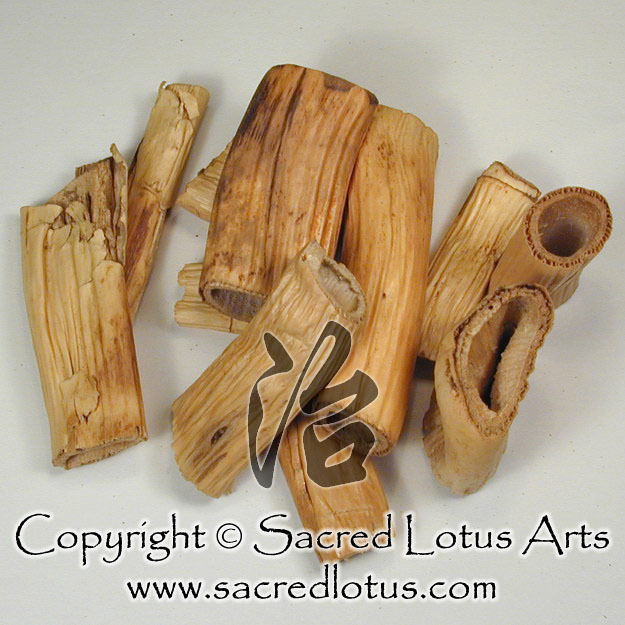
pinyin, latin category
Lú Gēn/Phragmitis Rhizoma 蘆根 pg.107
Standard species: Phragmites communis Trin.
Properties: sweet, cold Channel: LU, ST
Herbs that Clear Heat & Drain Fire
lu gen - f. u. r.
- LU & ST heat (but doesn’t retain pathogen)
- generates fluids without being cloying,
- alleviates nausea (ST heat),
- promotes urination
-esp for encouraging RASHES to surface.
(pediatric moreso get these)
1. Clears heat and generates fluids: for heat patterns with such symptoms as high fever, irritability, and thirst. Esp useful when the heat is accompanied by upward surging of rebellious qi. - use with tian hua fen, mai men dong. - this is Stomach and Lung heat.
a. Good for retching due to Stomach heat
2. Clears heat and promotes urination: for dark, scanty urine or blood in the urine, especially when accompanied by irritability and thirst. (not as good as Dan Zhu Ye)
3. Encourages rashes to surface*: for febrile diseases with rashes that are incompletely expressed.
- Primarily to clear lung heat
- Cools the stomach, generates fluids
- Can be used in the presence of an exterior condition as it does not retain pathogen
E.g. neice gets rashes during cold.
Maybe eczema px will get rashes during fever
Dosage: 15-30g
Cautions & Contraindications: Use with caution in those with cold from deficiency of the Spleen and Stomach.

pinyin, latin category
Zhi Mu/Anemarrhenae Rhizoma 知母 An-e-mer-rainy
Properties: bitter, sweet, cold Channel: Lung, Stomach, Kidney
Clear Heat and Drain Fire - ID
-F L Y S F
-clears fire and nourishes the yin
- Lung, Kidney, and Stomach
- fluids
1. Clears heat and drains fire: for high fever without chills, irritability, thirst, and a rapid flooding pulse 洪脈 in patterns of heat from excess in the Lungs and Stomach. - use with xuan shen, sheng di huang for oral ulcers,
2. Enriches the yin and moistens dryness: for exhaustion of deficiency of Lungs and Kidney yin with such heat signs as night sweats, steaming bone disorder, irritability, afternoon or low-grade fever, heat in the five centers, and bleeding gums. - use with bie jia for this condition.
3. Generates fluids and clears heat: for oral ulcers and inflammation due to yin deficiency, and for wasting and thirsting disorder. - use with tian hua fen and mai men dong
4. Ameliorates the dryness of tonifying or warming substances: for circumstances when tonifying herbs, such as huang qi , or warming herbs, such as gui zhi and fu zi are used - worried that these herbs are too drying.
- Bitter and cold and moistening.
Dosage: 15-60g
Cautions & Contraindications: contraindicated in cases of cold from deficiency of the Spleen and Stomach, or diarrhea